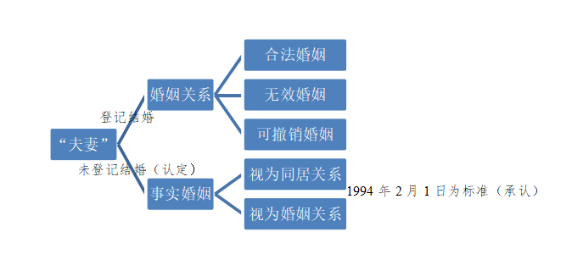"De facto marriage" after the Civil Code
overview
"With the construction of the rule of law in society, people's legal awareness has been greatly improved. It is rare to see marriages not being registered, but in some areas where legal awareness was still shallow in the past, marriage registration has not received enough attention, and even some people with ulterior motives simply ignore the legal system of marriage registration. According to the provisions of our law, marriages should be registered. Only after the marriage has been legally registered by the marriage registration office will the marriage relationship be protected by law. Those cases in which they live together in the name of husband and wife without registration with the marriage registration office are what we call de facto marriages.
01
The difference between a de facto marriage and a void marriage
China's law stipulates that a valid marriage shall be registered as a marriage, and the relationship between husband and wife is established by obtaining a marriage certificate, and has since been protected by law. The main feature of de facto marriages is that they have not been registered, which is obviously contrary to the law, so the attitude towards marriage registration in Article 1049 of the Civil Code is clear, that is, legal marriages must be registered. In other words, because a de facto marriage is not registered and does not meet the formal requirements of a legal marriage, it is not a legal marriage recognized by the law, and naturally cannot receive the same protection as the law has for legal marriage. It should be noted that a de facto marriage is not a null and void marriage, because a de facto marriage is a "cohabitation" relationship without being recognized by law, and it is not a "marriage" relationship, and there is no question of the legal validity of a valid or invalid marriage. However, an invalid marriage is registered in form, which meets the requirements for the form of marriage, but because it belongs to the invalid marriage situation stipulated by law, it is empty of the form of "marriage" and does not have the legal effect of marriage. The essential difference between the two is that de facto marriages often have the substantive requirements for a valid marriage, but because they have not been legally registered, the legal validity of their marriage needs to be further recognized by law. However, although an invalid marriage is registered, it violates the substantive requirements of a legal marriage and has no legal effect on marriage ab initio.
02
Recognition and recognition of de facto unions
On 1 February 1994, the Regulations of the Ministry of Civil Affairs on the Administration of Marriage Registration came into force, regulating marriage registration. The original Judicial Interpretation I of the Marriage Law accordingly provided for a watershed in the form of de facto marriages: "Before the promulgation and implementation of the Regulations on the Administration of Marriage Registration of the Ministry of Civil Affairs on 1 February 1994, if both men and women have met the substantive requirements for marriage, they shall be treated as de facto marriages. After the promulgation and implementation of the Regulations on the Administration of Marriage Registration issued by the Ministry of Civil Affairs on February 1, 1994, if both men and women meet the substantive requirements for marriage, the people's court shall inform them to apply for a supplementary marriage registration before accepting the case; If the marriage registration is not re-registered, it shall be treated as the dissolution of the cohabitation relationship. "This means that since 1 February 1994, the legal relationship of marriage is subject to marriage registration as a requirement for validity, and if the marriage is not registered, even if they live together in the name of husband and wife, the legal effect of marriage does not occur, but it is a cohabitation relationship. Although the Marriage Law was abolished after the Civil Code came into force, the relevant judicial interpretations of the Marriage Law also became a source of water. However, the law's attitude towards "de facto marriage" should not have changed, that is, "de facto marriage" after February 1, 1994 should be treated as a cohabitation relationship, and the parties would not enjoy the right of inheritance, maintenance and other marital rights. For "de facto marriages" before 1 February 1994, the law recognizes the legal validity of the marriage and receives the same legal protection as legal marriages.
It should be noted that the date of 1 February 1994 is only a criterion for determining whether a de facto marriage has the legal effect of marriage, not a criterion for determining a de facto marriage. For de facto marriages, there are two levels of legal meaning, namely recognition and recognition. The so-called recognition is the composition of a de facto marriage. The so-called recognition, that is, whether a de facto marriage can be protected by the law as it is a legal marriage. The cessation of the recognition of de facto unions after 1 February 1994 means that the law no longer protects de facto unions by the standard of legal marriages, but it does not deny the existence of de facto unions, and in many other legal systems it is still necessary to recognize de facto unions, and recognition does not mean recognition. In other words, the law recognizes de facto marriage through constituent elements, but whether the recognized de facto marriage recognizes its legal validity is another matter, and the two need to be distinguished.
The recognition of de facto marriage is related to the legal basis for adjusting the relationship of rights and obligations between the parties to a de facto marriage, and the recognition of de facto marriage is of great practical significance on the issue of bigamy. Bigamy, prohibited by our law, not only refers to marital and family disputes in the civil field, but also includes the crime of bigamy in the criminal field. The composition of bigamy generally includes the following four situations: (1) the registration of the marriage for the duration of the marriage, and the registration of the marriage separately. (2) During the duration of the registered marriage, another de facto marriage occurs; (3) During the duration of the de facto marriage, the marriage shall be registered separately; (4) During the duration of a de facto marriage, another de facto marriage occurs. The first situation is a typical act of registering bigamy, but it is relatively rare in practice. The parties concerned are generally afraid to register more than two marriages and obviously violate the law, and with the increasing standardization of the marriage registration system, the possibility of overlapping marriage registrations is very low. Therefore, the situation of bigamy is mainly manifested in the latter three situations, the common feature of which is that they all involve de facto marriages. If there are no rules for the recognition of de facto marriages, bigamy is impossible, and for offenders or even suspects who already have a spouse but maintain conjugal relationships with other members of the opposite sex, it may be easy to circumvent the law for their bigamy as long as the marriage is no longer registered. Therefore, whether the legal effect of a de facto marriage is recognized by law or not, there is a question of whether it constitutes a determination or not.
03
Determining the constituent elements of a de facto union
The constituent elements of a de facto marriage include substantive elements and formal requirements. The so-called substantive elements of a de facto marriage are the elements common to a de facto marriage and a legal marriage, mainly including:
1. Both parties subjectively have the intention to create a legal relationship between husband and wife and live together for a long time, and the intentions of both parties are the same;
2. Both parties have a common marital residence, and have a common sexual and economic life, or may have common children;
3. Both parties are commensurate externally in the name of husband and wife, and an unspecified majority of people are also recognized as husband and wife;
4. The parties do not have the circumstances of invalid marriage stipulated by law, that is, bigamy, close relatives, or under the legal age of marriage.
5. One party does not have coercion, concealment of major illness, etc. that meet the statutory circumstances of voidable marriage.
The formal requirement for the so-called de facto marriage is the failure to register the marriage. This is also the most essential difference between de facto marriage and legal marriage.

04
Conclusion and dissolution of de facto marriages
If a de facto marriage is not recognized by law, the legal effect of marriage does not occur, and there is no question of dissolution of marriage. However, if the recognized de facto marriage is recognized by law and has the legal effect of marriage, then, like a legal marriage, the dissolution of the marriage relationship shall also be by legal dissolution, that is, administrative means (to the civil affairs department) or litigation (to the people's court). In practice, civil affairs departments often do not accept requests for divorce by agreement of de facto marriages, because without marriage registration, civil affairs departments cannot determine the establishment of de facto marriages, and naturally cannot register and dissolve de facto marriages. Therefore, it is best to go to the people's court (that is, file a divorce lawsuit with the people's court) to dissolve a de facto marriage. It should be noted that in the case that a de facto marriage has not been legally dissolved, if a separate marriage is concluded, there is still a legal risk of bigamy.
(This article is translated by software translator for reference only.)
Related recommendations
- Can I get a tax refund if my bet fails? ——Comment on the case of Wang and Shanghai Taxation Bureau's refusal to refund taxes
- How shareholders can withdraw their shares Series 2: Company merger, division, or transfer of major assets
- From the Xiao incident to see the complex impact of spousal reporting - a double-edged sword in divorce proceedings
- Analysis of Criminal Legal Risks in Low altitude Economy and Preliminary Exploration of the Road to Criminal Compliance in Low altitude Economy



